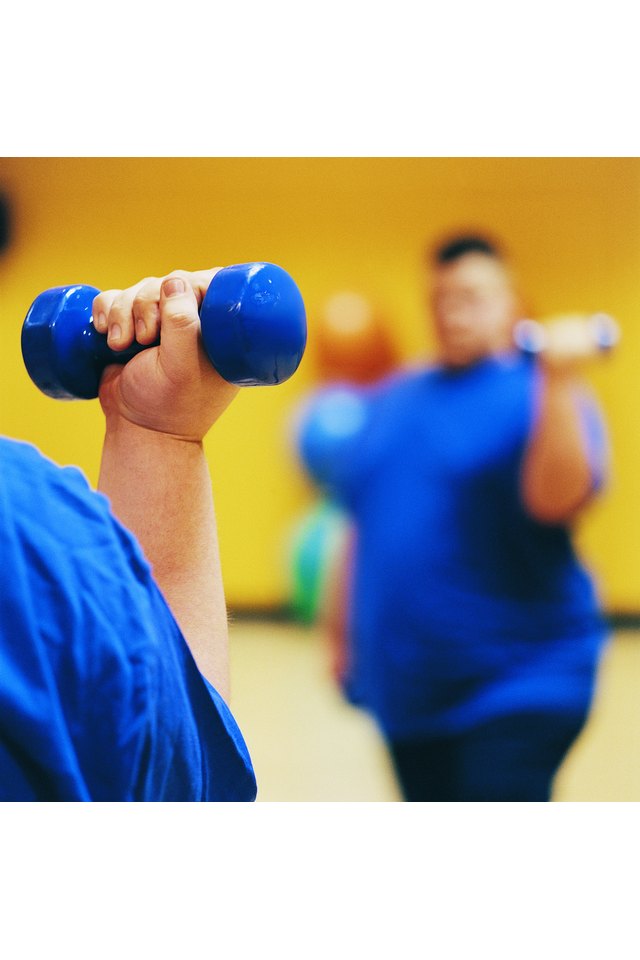How to Do a Pullup or Chinup When You're Fat

When you're overweight, it may be pretty obvious why it's more difficult to do a pullup or chinup -- you simply have more weight to pull in an upward direction. However, the benefits of these exercises are many, including toning and strengthening most of the muscles of the upper body, so don't give up just yet. While you may feel that you're a long way off from cranking out a full set, you can do a number of exercises to help yourself work up to the challenge. As you build muscle, you're giving yourself another added benefit: Muscle burns calories more efficiently than fat -- meaning you'll be burning more calories during subsequent workouts.
Strengthen your biceps with biceps curls. Pick up a set of dumbbells with a weight that seems moderately heavy -- meaning you could do a set of 10 to 15 repetitions with just a little bit of energy left over. If you're not sure which weight to start with, begin with a 1- or 5-pound weight and try to do a set of 15 repetitions of the biceps curl. Stand with your feet shoulder-width apart, palms facing front, and curl one dumbbell toward your shoulder. Then slowly lower the dumbbell and raise the dumbbell of the opposite hand. Do three sets of 10 to 15 repetitions on each arm, three days a week.
Strengthen the biceps and back muscles with the bent-over row exercise. Place a dumbbell of moderately heavy weight in your right hand, and then stand next to an exercise bench or other flat surface. Place your left knee on the bench, and lean forward to place your left hand about 1 to 2 feet from the knee. Push your right arm upward so it's parallel to the ground, and then slowly swing it forward until it reaches a 90-degree angle. Repeat this motion 10 to 15 times, take a short break, and then do two two more sets. Do the same motion with the opposite hand. Do this exercise three days a week.
Practice with the assisted pullup machine. You'll typically only find these machines at a gym, so get a trainer to help you if you don't know how to use it. Set the counterweight to a number slightly lower than your own weight, step onto the assistance bar and place your hands on the bars in an overhand grip. Then step onto the foot pad and work toward pulling yourself up. Do one repetition and take a break, then try to do another one. Work toward doing 12 one-repetition sets.
Lower the bar. According to Military.com, this is the way that soldiers work toward doing a full pullup, since you're only lifting a portion of your weight. Locate a bar about 4 feet from the ground -- you'll often find them at outdoor parks or gyms -- and sit on the ground with your hands in an overhand position on the bar. Pull yourself toward the bar, stopping when you get your chin over the bar. Try the one-repetition set here too; do one rep, stop and rest, and then try to do another one. Over time, work toward doing a two-repetition set, and then three, four, five and so on. Once you can do a set of multiple repetitions, move on to the regular pullup bar, setting a goal of one pullup or chinup at a time.
Tips
As with any strength-training routine, aim for three days a week, with a day of rest in between.
Since weighing less means less weight to pull up over the bar, also consider adding calorie-burning aerobic exercise into your routine to shed pounds. Start out small; walk, cycle or jog for 10 to 15 minutes, three days a week, and then add more time the next week. Keep a journal of your progress -- it can give you the motivation you need to keep setting higher goals.
Although pullups and chinups rely on basically the same movement, some trainers distinguish the two by the way the hands are positioned. Chinups have the hands facing toward the body, while pullups have the hands facing away from the body. You may find that chinups are easier to master.
References
Writer Bio
Nicole Vulcan has been a journalist since 1997, covering parenting and fitness for The Oregonian, careers for CareerAddict, and travel, gardening and fitness for Black Hills Woman and other publications. Vulcan holds a Bachelor of Arts in English and journalism from the University of Minnesota. She's also a lifelong athlete and is pursuing certification as a personal trainer.
